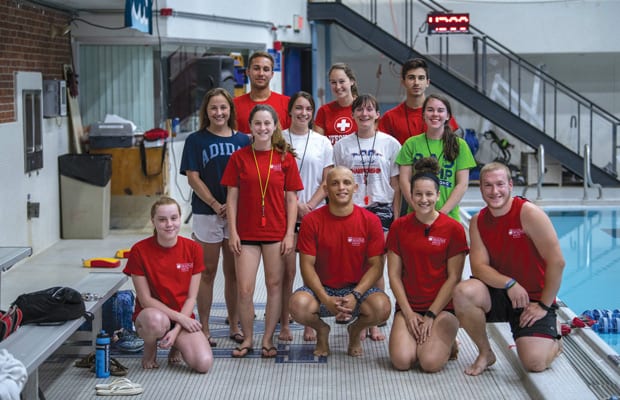When safety is involved, hiring aquatics staff is not taken lightly. Beneath the surface, there is much more to the job than being certified.
“When reviewing candidates for either of our positions, we look for individuals who not only are able to demonstrate proficiency in the knowledge or skills of the intended position, but who also embody the values of our program’s mission,” said Benjamin Pazian, the aquatics coordinator at the University of South Florida (USF).
To ensure he is picking the right candidates for the program, Pazian only hires American Red Cross certified lifeguards and water safety instructors (WSI) due to the history of characteristics these certification courses ingrain. “Doing so enables a smooth transition to our team and higher likelihood of the candidate’s buy-in to our core mission,” he elaborated.
Similarly, Adrianna Del Amo, the coordinator for fitness and aquatics at the University of Maine, also requires potential lifeguards to be American Red Cross certified. But for her swim instructors, she does not require a WSI certification to be hired.
“I just need someone who is passionate and is ready to learn and is willing to accept feedback,” said Del Amo. “I prefer swim instructors who come in with experience, of course, but I have an apprenticeship and a series of trainings that can teach an interested candidate how to teach swim lessons.”
In fact, Del Amo has found some of her best swim instructors come from non-aquatics backgrounds, such as education majors, because they are invested in learning how to teach a variety of mediums.
Other characteristics Del Amo looks for when hiring aquatics staff include paying close attention to detail and being preventative rather than reactive. “Both for lifeguarding and swim lessons, you need to be able to identify what the behavior looks like that might result in something bad,” she said.
Additionally, being able to use their resources is another compelling characteristic for hiring aquatics staff. This is why Del Amo always asks a specific question in her interviews: Tell me about a time when you were given an assignment and you lacked the necessary skills to complete it?
“What I’m looking for is they were able to succeed in some way, and they used the resources around them to resolve the issue they had of not knowing,” said Del Amo. “I tell them with our in-services, trainings and orientation, ‘I try to set you up for all circumstances you may encounter, but it’s impossible to set you up for every single situation you may encounter. Knowing where to find the answers is very important.’”

During the interview process at USF, candidates go through a formal interview and a physical skills test. In the formal interview, the aquatics coordinator, aquatics program assistant, and a few lifeguards or WSI certified staff are present for more insightful feedback from different perspectives.
“We have a set list of questions to ask, but we treat the interview as a conversation to allow the candidate to open up and express more of their personality,” said Pazian. “One of my favorite questions to ask during the interview is, ‘What value do you believe campus recreation aquatics brings to holistic the experience of USF?’”
Once a new staff member is welcomed, the USF on-boarding process consists of three major phases over a full-day orientation:
Phase One: An overview of the standard operating procedures and emergency action plans, as well as a review of the staff manual with a coordinator, covering all policies, procedures and approaches to emergency response.
Phase Two: A walkthrough of all facilities that provides perspective to the material in the manual, including taking the candidates around during open-swim times so they can speak to peers who will guide them through methods and provide any necessary tips.
Phase Three: All new hires dive in the water with lifeguards or WSI certified staff. They run through all the American Red Cross rescues or teaching skills blended with USF practices to become familiar with the characteristics of equipment and procedures. Additionally, the candidates go through scenarios multiple times, and are provided constructive feedback while honing-in on communication and leadership skills.
What do you do when faced with choosing between candidates? Pazian suggests valuing personality above raw skills. “As long as the candidate is meeting your base physical requirements, the skills can be refined later in the on-boarding process,” he explained. “Since utilizing this approach, I have noticed a significant decrease in staff-related issues and a stronger bonded team.”
While initially picking the right candidate and going through the proper training is important, so is continued learning and communication among the aquatics team. This is why Del Amo puts such a strong emphasis on meeting with all of her staff as often as she can and staying in communication with her lifeguards.
“I am always asking my staff, checking in with them and asking if there is anything that can be changed and done better,” she said. “Most of the time, they have some really good ideas and I like to foster and encourage that.”










